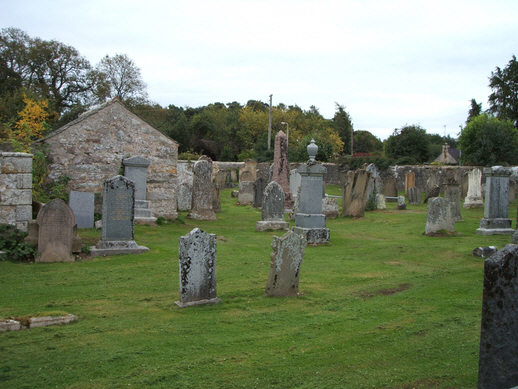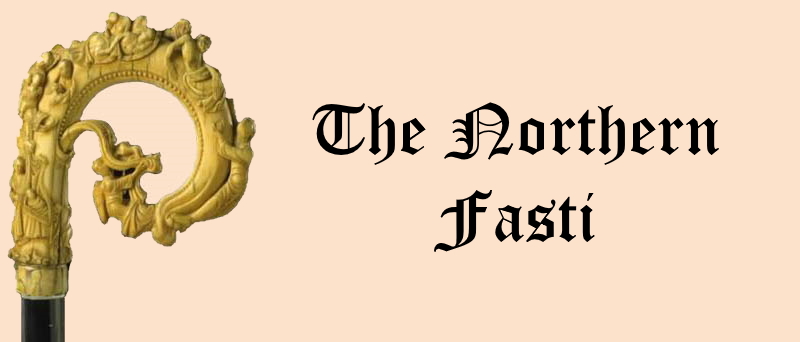Elgin Deanery
Rafford
(Ratheforde or Rathed)
Parish Church: OS Ref: NGR NJ 060562 H.E.S. No: NJ05NE 5 Dedication: St Maelrubha.
Associated Chapels: Meads of St John {NGR NJ 0016552}
The parish of Rafford consisted of, the three-dabhach land of Tarras, in the north, and the two-dabhach land of Blair (Blervie), in the south.1 As such, Rafford was a comparatively small parish. But, what it lacked in size, it made up for in antiquity. The dedication to St Maelrubha points to there having been a church of some kind at Rafford from the very earliest days of Christianity. In the medieval era we find Rafford being mentioned in the diocesan records as early as 1207x1208.2
In the register of valuation of benefices, dating to 1564, the 'temporality' of the bishopric is stated to consist of the baronies of Spynie, Kynnedour (Kineddar), Birnethe (Birnie),

Originally, the church of Rafford was a part of the prebend of the Precentor of the cathedral. He had Rafford and also the churches of Lhanbryde and Alves, along with a dabhach of land at the latter. As the 'establishment' serving the cathedral of Moray expanded, there was a need to provide the Precentor with an assistant - a Sub-Precentor, known as a Succentor - and Bishop Andrew de Moravia, in creating this new position, also created a prebend to support the clerics who would hold the post. Since the Succentor was to share some of the Precentor's duties it was only logical that this new prebend should be formed from parts of the Precentor's prebend. Bishop Andrew 'sliced' the church of Rafford away from the Precentor and to it he added the church of Ardclach (which was possibly held previously by the bishop himself). The Precentor was, however, to receive four marks yearly from the fruits of Rafford so that the revenues he received from his prebend were not too drastically reduced.4 However, this arrangement was not without its problems and it is recorded that, c.1328, a lengthy {and expensive} dispute between the Precentor (Roger) and the Succentor (Martin) had eventually been settled, but only after the matter had been referred to the Curia and Papal Judges Delegate had been appointed to resolve the dispute over where exactly the boundaries between Alves and Rafford lay.5
There was a corn mill at Rafford from at least 1565 when it was included in the 'Rentale'.6 It was situated at Marcussy (Marcassie
The parish of Kinloss was formed from a part of Alves parish and a part of Rafford, 1652x59. The Kinloss Burn must have been the basis of the boundary between these medieval parishes.
The churches of Rafford and Altyre were then united on 20 March, 1661.
| Name | OS Grid Ref. | Extent | Comment |
|---|---|---|---|
| West Tarras | NJ | 1 dabhach | |
| Mid Tarras | NJ 06_59_ | 1 dabhach | |
| East Tarras | NJ 06_59_ | 1 dabhach | |
| Blare Superior | NJ | 1 dabhach | Part of Blervie. Overblairie. |
| Blare Inferior | NJ | 1 dabhach | Part of Blervie. Netherblairie. |
| Lochillis | NJ 056592 | 2 ploughgates | Part of West Tarras. (Probably Lochyhill.) |
| Calsafuird | NJ 050598 | 2 ploughgates | Cassieford. Part of West Tarras. |
| Burgie | NJ 090595 | 1 ploughgate |
The lands of Burgie (and Grange) were held by the monks of Kinloss up to the Reformation. The last abbot of Kinloss, Robert Reid, gave both of them to his niece, Katherine Reid, and they were part of her 'dowery' when she married Alexander Dunbar, one of the Lords of Session, c.1567. His son, Thomas Dunbar, was father of Robert of Grange by a first marriage, and of Robert of Burgie by a second. The lands of Tarras
Only a little distance west of Rafford is the church of Altyre
In later times, there was a (?Grammar) School at Rafford, and amongst its pupils was one James Dick (1743-1828), the son of a shoemaker in Forres, some 3 miles away. Having, with his brother John, made a fortune in Jamaica, James returned to Scotland. In time, he inherited his brother's half of the fortune. After making provision for his daughter, James, in his will, set up a bequest fund to help the schoolmasters and schools in Aberdeenshire, Banffshire and Morayshire. The fund was administered by trustees belonging to the Society of Writers to the Signet. Applicants were rigorously examined for suitability and were required to be proficient in teaching classical languages, humanities, mathematics and science; those who were successful doubled their salaries. The Dick Bequest has been one of the principal reasons for the educational standards of the north-east of Scotland becoming amongst the best in the world.
1215 (22 December) Confirmation and protection, from Pope Innocent III, of the details contained within Bishop Bricius' Magna Carta [Moray Reg., 46], in which is mentioned "ecclesiam de Ratheforde". The charter was given at the Lateran, 11 Kalends Jan. [Moray Reg., 47]
1226-1328 {The church of Rathed (Rafford) is mentioned in a number of charters between 1226 - 1328.} [Moray Reg., 69, 77, 81, 137]
1547 (20 June) Charter recording that the Bishop of Moray, {Patrick Hepburn}, with the consent of his Chapter, had set at feodifirmae to Alexander Cummyn, jnr., lord of Ernished {Earnside}, and Egidiae Blacater {Egidia Blackadder}, his wife, the lands of Mekill Phorpe in the barony Raffort, and sheriffdom of Elgin and Forres
A precept of sasine was given on the same day at the place in question and ratified by the same witnesses. [Moray Reg., (Carte Recentiores Abbreviate), 432-33.]
1567 (20 May) Charter of 'feuferme' of the Bishop of Moray {Patrick Hepburn}, with the consent of his Chapter, conceding to Alexander Dunbar of Chonzie, the lands of Raffart {Rafford}, Barcarisbank {?}, Brachot {?}, Netherblairie, Overblairie, and Granroquhie {Granary?}, in the barony of Rafford, within the sheriffdom of Elgin and Forres. Paying to the bishop £55. 7. 7½ per annum. At the end of the charter is included the command of sassine {to}, James Innes of Drainie, Robert Innes his son, Robert Tulloch, baillie. Witnesses: David Cuming, Andrew Moncrieff, Andrew Boyn notary, James Tarres, James Johnstone, and John Annan, notaries. Given at the Palace of Spynie and at Elgin, 20 May 1567. [Moray Reg., (Carte Recentiores Abbreviate), 445.]
Chapel of St John: St John the Baptist's Chapel stood, in 1390, towards the northern extremity of the part of the Meads of St John which lay on the east bank of the River Findhorn, in the parish of Rafford. A local story told to Sapper James Gray, Royal Engineers, who recorded it in the OS Name Book, was that, "this was the place where a great Tournament was arranged by the Earl of Moray for the nobility of Scotland and a few knights of England. The Earl of Buchan and Ross, better known by [the title of] the Wolf of Badenoch, having been excommunicated at the time by Bishop Barr of Elgin, was not admitted to the Tournament. In anger of the same, the earl rode straight to the town of Forres and set it on fire and from thence went to Elgin and burned the Cathedral."10 Its is said that, "according to local information, about five years ago, several human skeletons were discovered immediately south of the cottage" at
Scott (1926) averred that, "a small monastic foundation stood at St John's Mead in Rafford."12 It seems that we must accept the existence of a medieval chapel but the monastery is uncertain, although, since the area was certainly on a route used by some of the saints of the Early Church period, then we might be allowed to suggest that the 'monastery' could have been a muinntir.
1. Ross, A.D. (2003) The Province of Moray, c.1000-1230, unpublished PhD thesis presented to Aberdeen University, Vol 1, 70. Return
2. Moray Reg., 46. Return
3. Moray Reg., Introduction, xix. Return
4. Moray Reg., 69. Return
5. Moray Reg., 137. Return
6. Moray Reg., 'Episcopatus Moaviensis Rentale', p.446. Return
7. Shaw, L. (1775) The History of the Province of Moray, Vol.2, J.F.S. Gordon (ed.) (1882), Edinburgh: Hamilton, Adams, & Co., 177. Return
8. ibid., 54. "Sir Thomas Cuming of Altyre, some time before 1411, obtained certain lands within the barony {of Dallas}, and in 1419 received a license from James I to erect a castle or fortilace at Dallas." Return
9. ibid., 180-181. Return
10. Ordnance Survey Name Books, 1868-71, Morayshire, volume 23, OS1/12/23/14 https://scotlandsplaces.gov.uk/digital-volumes/ordnance-survey-name-books/morayshire-os-name-books-1868-1871/morayshire-volume-23/14 Return
11. HES Canmore Database, Permalink http://canmore.org.uk/site/15786 Return
12. Scott, H. et al (eds.) (1926) Fasti ecclesiae Scoticanae: the succession of ministers in the Church of Scotland from the Reformation, Revision. Vol. 6, Synods of Aberdeen and of Moray. Edinburgh: Oliver and Boyd, 427. Return
e-mail: admin@cushnieent.com
© 2021 Cushnie Enterprises

